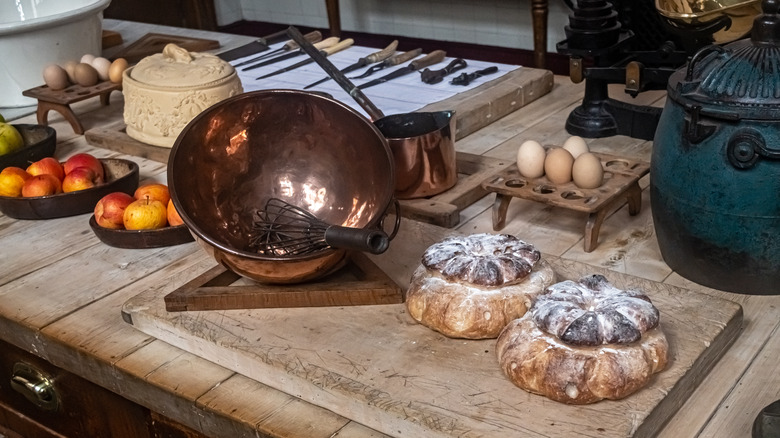Bread In The Victorian Era Was Hiding A Toxic Secret
The Victorian era of England describes the period of time between 1837 and 1901, or the reign of Queen Victoria in Great Britain. It was an extraordinary time of growth in many areas, especially for cities, which experienced a boom in population and industries. With an increase in wages, many could suddenly afford various luxuries, including more food.
Much pressure was put on people like bakers, who needed to have enough product to feed the masses (not to mention pad their own pockets). In order to quickly produce bread at the cheapest cost possible, many bakers began to add things like plaster of Paris, bean flour, ground up bones(!), chalk, and an aluminum-derived compound called alum to their loaves. These ingredients added weight and resulted in bread that was a stark white color, which was considered desirable.
Whether from ignorance or carelessness, bakers and consumers probably couldn't predict the health repercussions of eating bread tainted with things like alum, and many preventable deaths likely occurred for the sake of plain white bread. Indeed, the life expectancy for Victorians in 1850 was only 40 years for men and 42 for women.
The heavy cost of whiter bread
During the Victorian era, it became en vogue to shift from dark breads to white breads for a number of reasons. While many preferred the taste and texture of white bread, others associated the color with purity, and therefore assumed it was unadulterated (which couldn't be further from the truth). Some thought white breads were easier to digest and more nutritious, and high society preferred them.
Alum specifically was an inexpensive way to add heft and whiteness to bread, but unfortunately caused a number of health issues in the human body, including indigestion, constipation, and diarrhea. And because alum reacted adversely with stomach acid, consumers could not digest the bread properly, which led to malnutrition in the most severe cases. Among the most susceptible to this condition were the working class and children, who relied on commercially baked bread (versus home baked, nutritious loaves) as a large part of their daily diets.
Any sort of "bulking" ingredient (like the aforementioned plaster of Paris and disgusting addition of bones) would take away nutritional value from bread, but alum was particularly harmful because it ultimately weakened one's immune system. In the mid 1850s, John Snow, a physician and advocate for the working people, theorized the link between the poor health of British citizens and the bread they were eating, a hypothesis that would be proven by science 70 years later.
Bread wasn't the only food affected by dangerous additives
It wasn't just bread that Victorian era citizens had to beware of. Plenty of other baked goods, no matter how colorful or pretty they were, could also potentially be laced with chemicals that had no business being in food. Chromate of lead was a popular yellow coloring agent, but caused lead poisoning, and was responsible for almost killing six boys in 1859 because a baker colored his bread buns with it. Poisonous vermilion (red sulphuret of mercury) imparted a red-orange color, while green-colored pastries were sometimes treated with copper acetate, which was also very toxic. Today, the latter is used in things like insecticide and fungicide.
In 1858, over 200 people fell ill and 20 died when they ate sweets that were accidentally tainted with arsenic, which had been mistaken for plaster of Paris. Milk was also not always safe. It was believed that adding boracic acid to milk would "purify" it, but it actually led to terrible digestive issues. Plus, bovine tuberculosis bacteria was rampant in milk, which led to as many as 500,000 children dying during the era. Russia's method of preserving milk with frogs sounds downright practical compared to this.
Despite the tremendous advances in society during this period of time, it was also marked by countless unnecessary deaths and illnesses. Fortunately, the following era (Edwardian) was full of many positive medical advancements, including the discovery that germs cause diseases (better late than never!).


